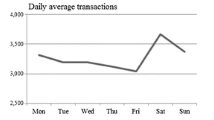Abstract
This paper addresses the problem of flexible shift scheduling of service employees at mail processing and distribution centers. Our main objective is to determine staffing levels for different worker categories subject to a host of union restrictions and general labor regulations. The problem is modeled as a mixed-integer linear program and solved with branch and price algorithm. Using real data provided by a US Postal Service a variety of computational experiments are performed to quantify the benefits of scheduling flexibility. These include different shift starting times, different shift lengths, a lunch break allowance, and different days-off assignments. In addition, the ratio between regular and flexible workers is varied to investigate its effect on costs. The results show the efficiency of the proposed procedure. Finally, we offer some managerial insights gained from the analysis.





Similar content being viewed by others
References
Alfares, H. K. (1997). An efficient two-phase algorithm for cyclic days-off scheduling. Computers & Operations Research, 25(11), 913–923.
Bailey, J. (1985). Integrated days off and shift personnel scheduling. Computers & Industrial Engineering, 9(4), 395–404.
Barnhart, C., Johnson, E. L., Nemhauser, G. L., Savelsbergh, M. W. P., & Vance, P. H. (1998). Branch-and-price: Column generation for solving huge integer programs. Operations Research, 46(3), 316–329.
Bard, J. F., Binici, C., & deSilva, A. H. (2003). Staff scheduling at the United States Postal Service. Computers & Operations Research, 30(5), 745–771.
Bard, J. F. (2004). Staff scheduling in high volume service facilities with downgrading. IIE Transactions on Scheduling & Logistics, 36(10), 985–997.
Bechthold, S. E., & Jacobs, L. W. (1990). Implicit Modeling of flexible break assignment in optimal shift scheduling. Management Science, 36(11), 1339–1351.
Berman, O., Larson, R. C., & Pinker, E. (1997). Scheduling workforce and workflow in a high volume factory. Management Science, 43(2), 158–172.
Blöchliger, I. (2004). Modeling staff scheduling problems: A tutorial. European Journal of Operational Research, 158(3), 533–542.
Brunner, J. O., Bard, J. F., & Kolisch, R. (2009). Flexible shift scheduling of physicians. Health Care Management Science, 12(3), 285–305.
Brunner, J. O., Bard, J. F., & Kolisch, R. (2011). Midterm scheduling of physicians with flexible shifts using branch-and-price. IIE Transactions on Operations Engineering & Analysis, 43(2), 84–109.
Burke, E. K., De Causmaecker, P., Berghe, G. V., & Van Landeghem, H. (2004). The state of the art of nurse rostering. Journal of Scheduling, 7(6), 441–499.
Cezik, T., Gunluk, O., & Luss, H. (2001). An integer programming model for the weekly tour scheduling problem. Naval Research Logistics, 48(7), 607–624.
Cheang, B., Li, H., Lim, A., & Rodrigues, B. (2003). Nurse rostering problems—A bibliographic survey. European Journal of Operational Research, 151(1), 447–460.
Dantzig, G. B., & Wolfe, P. (1960). Decomposition principle for linear programs. Operations Research, 8(1), 101–111.
Desaulniers, G., Desrosiers, J., & Solomon, M. M. (Eds.) (2005). Column generation. New York: Springer.
Ernst, A. T., Jiang, H., Krishnamoorthy, M., & Sier, D. (2004a). Staff scheduling and rostering: A review of applications, methods and models. European Journal of Operational Research, 153(1), 3–27.
Ernst, A. T., Jiang, H., Krishnamoorthy, M., Owens, B., & Sier, D. (2004b). An annotated bibliography of personnel scheduling and rostering. Annals of Operations Research, 127(1), 21–144.
Kohl, N., & Karisch, S. E. (2004). Airline crew rostering: Problem types, modeling, and optimization. Annals of Operations Research, 127, 223–257.
Mandelbaum, A. (2006). Call centers (centres) research bibliography with abstracts. Version 7. Available at http://ie.technion.ac.il/serveng/References/US7_CC_avi.pdf.
Morris, J. G., & Showalter, M. J. (1983). Simple Approaches to shift, days-off and tour scheduling problems. Management Science, 29(8), 942–950.
Schultz, K. L., McClain, S. O., & Thomas, L. J. (2003). Overcoming the dark side of worker flexibility. Journal of Operations Management, 21, 81–92.
Purnomo, H. W., & Bard, J. F. (2006). Cyclic preference scheduling for nurses using branch and price. Naval Research Logistics, 54, 200–220.
Stolletz, R. (2010). Operational workforce planning for check-in counters at airports. Transportation Research Part E: Logistics and Transportation Review, 46(3), 414–425.
Thompson, G. (1995). Improved implicit optimal modeling of the labor shift scheduling problem. Management Science, 41(4), 595–607.
Vanderbeck, F. (1994). Decomposition and column generation for integer programs. Ph.D. thesis. Faculté des Sciences Appliqées, Université Catholique de Louvain, Louvain-la-Neuve.
Vanderbeck, F. (2000). On Dantzig-Wolfe decomposition in integer programming and ways to perform branching in a branch-and-price algorithm. Operations Research, 48(1), 111–128.
Vanderbeck, F., & Wolsey, L. A. (1996). An exact algorithm for IP column generation. Operations Research Letters, 19, 151–159.
Wosley, L. A. (1998). Integer programming. New York: Wiley.
Author information
Authors and Affiliations
Corresponding author
Appendix: Supporting figures and tables
Rights and permissions
About this article
Cite this article
Brunner, J.O., Bard, J.F. Flexible weekly tour scheduling for postal service workers using a branch and price. J Sched 16, 129–149 (2013). https://doi.org/10.1007/s10951-011-0265-6
Published:
Issue Date:
DOI: https://doi.org/10.1007/s10951-011-0265-6






